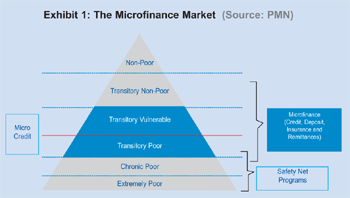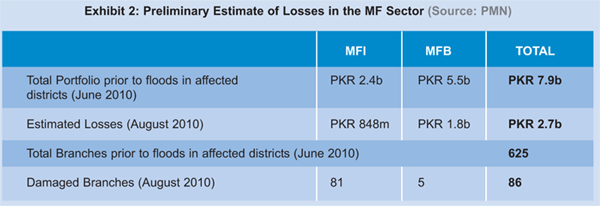As is the case in most natural disasters, the group most dramatically impacted is the poor. The 2010 Floods in Pakistan have been no exception to this rule. The vulnerable, the borderline poor and those groups under the poverty line have been swept even further below the poverty line than they were before.
These groups have traditionally been the main target clientele for the microfinance industry: those segments of the population that straddle the poverty line – the transitory poor and the transitory vulnerable, (see Exhibit 1: The Microfinance Market). These are the segments of society who are economically active – they work for themselves or for others, have some marketable skill and have earning potential, realized or unrealized. These are the potential entrepreneurs that microfinance targets.

Microfinance clients might even be unemployed, trying their hand for the first time at entrepreneurship. Microfinance Providers (MFPs) cater to clients who are excluded from the main stream of financial services as commercial banks do not find it viable to target this segment. As is the case globally, in Pakistan also microcredit clients predominantly fall in the segments that are just above and below the poverty line.
2010 Floods Impact on MF Industry
To set the context, preliminary estimates show that the direct losses to the microfinance sector due to the 2010 Floods are in the form of direct portfolio losses and damage to branches in flood affected areas (Exhibit 2: Estimated Losses in the MF Sector).

These loss estimates have been consolidated at the Pakistan Microfinance Network (for Rural Support Programs and Microfinance Institutions) and at the State Bank of Pakistan for Microfinance Banks. Losses are self‐reported figures from Microfinance Providers.
It can be anticipated that there will be indirect effects of the floods on the sector as well; many urban microfinance clients have rural linkages i.e. families who still reside in their native villages and depend, partially or completely, upon them for money, or family members who have been hit by the floods migrate to cities and reside with these clients thereby creating additional expenses. It is also anticipated that inflationary pressures, especially food prices due to the crop damages, will impact the segment that microfinance sector seeks to serve. Rising cost of business will also impact the microfinance providers.
MF Post-Flood Scenario
Microfinance Providers have had to be proactive in alleviating the negative impact of the destruction on the lives and livelihoods of their clients. The Pakistan Microfinance Network held a Roundtable Conference in mid-September 2010 where important lessons were shared for both policy makers and practitioners as they think about the next steps in helping their clients as well as tailoring their programs to meet their needs.
Relief-MF Overlap
There are no standard post-disaster microfinance guidelines but relief distribution can be used to support the microfinance sector rather than undermine it. Most microfinance providers in Pakistan have taken the opportunity to engage more deeply with the communities they work with. In a post-disaster situation there is blurring of the line between relief and microfinance operations and we see there has, in some instances, certainly been an overlap of humanitarian relief efforts and the microfinance operations even in the current scenario.
That said, international experiences in Sri Lanka, Indonesia and Haiti caution against mixing the two. It has been seen that when MFPs engage in channeling grants to their clients, especially cash, it distorts credit discipline and confuses clients. It is better to collaborate with safety net programs for delivery of such relief.
Sustainable Solutions
A key concern in this and any post-disaster situation is to find sustainable solutions – relief is immediate but has no long term impact beyond giving policy makers and stakeholders a window of time to implement strategic solutions. Capacity building within organizations working with the poor, specifically MFPs, adapting and building their management abilities and credibility are essential.
At the client level, thorough assessment of clients is required before any write offs are announced. Certainly there will be many clients who will need permanent waivers but there will also be many who require a moratorium of repayments or rescheduling. Advice thus is not to rush into any blanket waivers. The need for loans, and saving products, can actually increase due to a disaster situation. Product requirements may however be different and MFPs need to understand the needs of the flood victims – they may need new capital recovery loans with subsidized interest for a few loan cycles and flexible terms. Thus do not suspend microfinance operations but tailor them to the new needs of the affected clients.
Support for the Sector
The 2010 Floods have clearly demonstrated how MFPs can prove to be effectual first responders to crises since they already have an existing on ground network in communities that are desperate for assistance. Collaborations and partnerships have been beneficial for delivery of relief. Moreover, in-kind grants to reestablish income generating activities, client counseling and training can help in swiftly re-building lost enterprises. Moreover, proactive assistance helps build and maintain client loyalty
The industry requires support at this point. However whatever mechanisms are devised to deliver this support (through write-offs, price subsidies and/or rescheduling with creditors), these must maintain credit discipline in the long run and help the clients. Any fiscal support that is provided should be used to support both MFIs and MFBs. This is also an opportunity to put in place long term solutions such as a refinancing window created to meet liquidity needs and the creation of a risk mitigation fund for the sector. In case support is not forthcoming, we can anticipate adverse ramifications for not only microfinance outreach and social impact but also for entrepreneurship and employment in the country.





